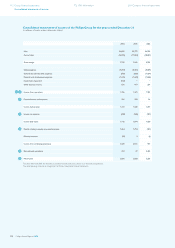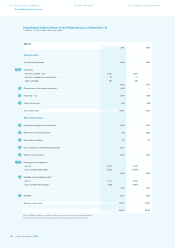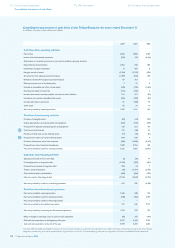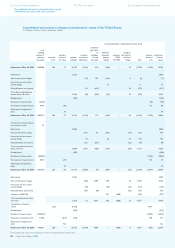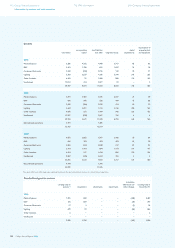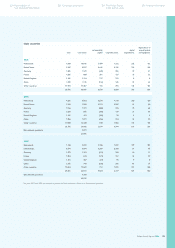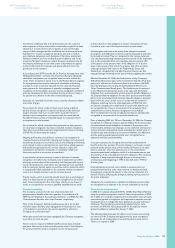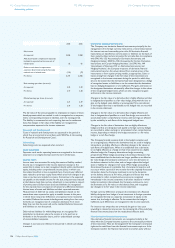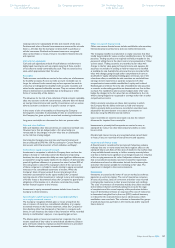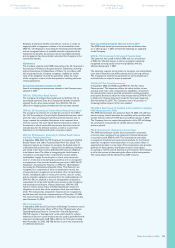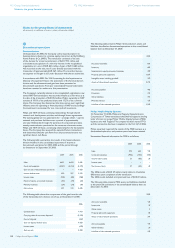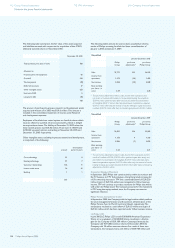Philips 2006 Annual Report Download - page 124
Download and view the complete annual report
Please find page 124 of the 2006 Philips annual report below. You can navigate through the pages in the report by either clicking on the pages listed below, or by using the keyword search tool below to find specific information within the annual report.
Philips Annual Report 2006124
The consolidated fi nancial statements are prepared in accordance
with generally accepted accounting principles in the United States
(US GAAP). Historical cost is used as the measurement basis unless
otherwise indicated.
Consolidation principles
The consolidated fi nancial statements include the accounts of
Koninklijke
Philips Electronics N.V. (the ‘Company’) and all entities
in which a direct or indirect controlling interest exists through voting
rights or qualifying variable interests. All intercompany balances and
transactions have been eliminated in the consolidated fi nancial
statements. Net income is reduced by the portion of the earnings
of subsidiaries applicable to minority interests. The minority interests
are disclosed separately in the consolidated statements of income
and in the consolidated balance sheets.
The Company applies Financial Accounting Standards Board (FASB)
Interpretation No. 46(R) ‘Consolidation of Variable Interest Entities’.
In accordance with this Interpretation of Accounting Research Bulletin
No. 51 ‘Consolidated Financial Statements’, the Company consolidates
entities in which variable interests are held that would require the
Company to absorb a majority of the entity’s expected losses, receive
a majority of the entity’s expected residual returns, or both.
Foreign currencies
The fi nancial statements of entities that use a functional currency
other than the euro, are translated into euros. Assets and liabilities
are translated using the exchange rates on the respective balance
sheet dates. Income and expense items in the income statement and
cash fl ow statement are translated to euros at exchange rates at the
dates of the transaction. The resulting translation adjustments are
recorded as a separate component of other comprehensive income
(loss) within stockholders’ equity. Cumulative translation adjustments
are recognized as income or expense upon partial or complete
disposal or substantially complete liquidation of a foreign entity.
The functional currency of foreign entities is generally the local
currency, unless the primary economic environment requires the use
of another currency. When foreign entities conduct their business
in economies considered to be highly infl ationary, they record
transactions in the Company’s reporting currency (the euro) instead
of their local currency.
Gains and losses arising from the translation or settlement of foreign-
currency-denominated monetary assets and liabilities into the local
currency are recognized in income in the period in which they arise.
However, currency differences on intercompany loans that have the
nature of a permanent investment are accounted for as translation
differences as a separate component of other comprehensive income
(loss) within stockholders’ equity.
Use of estimates
The preparation of fi nancial statements requires management to
make estimates and assumptions that affect amounts reported in the
consolidated fi nancial statements in order to conform to generally
accepted accounting principles. These estimates and assumptions
affect the reported amounts of assets and liabilities, the disclosure
of contingent liabilities at the date of the consolidated fi nancial
statements, and the reported amounts of revenues and expenses during
the reporting period. We evaluate these estimates and judgements on
an ongoing basis and base our estimates on experience, current and
expected future conditions, third-party evaluations and various other
assumptions that we believe are reasonable under the circumstances.
The results of these estimates form the basis for making judgements
about the carrying values of assets and liabilities as well as identifying
and assessing the accounting treatment with respect to commitments
and contingencies. Actual results could differ from the estimates and
assumptions are further explained in the related notes.
Estimates signifi cantly impact goodwill and intangibles acquired, tax on
activities disposed, impairments, liabilities from employee benefi t plans,
various provisions including tax and other contingencies. The fair
values of acquired identifi able intangibles are based on an assessment
of future cash fl ows.
Impairment analyses of goodwill and indefi nite-lived intangible assets
are performed annually and whenever a triggering event has occurred
to determine whether the carrying value exceeds the recoverable
amount. These calculations are based on estimates of future cash fl ows.
Accounting changes
The Company applies the retrospective method for reporting a change
in accounting principle in the absence of explicit transition requirements
for new accounting pronouncements.
Reclassifi cations
Certain items previously reported under specifi c fi nancial statement
captions have been reclassifi ed to conform to the 2006 presentation.
The caption ‘Investments in unconsolidated companies’ in the balance
sheet was renamed ‘Investments in equity-accounted investees’ to
improve the relationships between captions and accounting policies.
Investments accounted for at cost have been reclassifi ed to ‘Other
non-current fi nancial assets’.
Further, the line item ‘Write-off of acquired in-process research and
development’ has been reclassifi ed from a separate caption in the
income statement to ‘Research and development expenses’, since
this disclosure is provided in the notes.
Discontinued operations and non-current assets held for sale
Based on Statement of Financial Accounting Standards (SFAS) No. 144
‘Accounting for the Impairment or Disposal of Long-Lived Assets’
the Company has determined that the level of a reporting unit is the
component within Philips for which operations and cash fl ows can be
clearly distinguished from the rest of the Company and qualifi es as a
discontinued operation in the event of disposal of the component.
A component of Philips qualifi ed as a reporting unit is usually one level
below the division level. Any gain or loss from disposal of a reporting
unit together with the results of these operations until the date of
disposal, is reported separately as discontinued operations. The fi nancial
information of a discontinued reporting unit is excluded from the
respective captions in the consolidated fi nancial statements and related
notes and is reported separately.
Due to the sale of a majority stake in the Semiconductors division
in September 2006, the Company’s consolidated fi nancial statements
for the years 2004 and 2005 have been restated to present the
Semiconductors division as discontinued operations.
Cash fl ow statements
Cash fl ow statements have been prepared using the indirect method
in accordance with the requirements of SFAS No. 95, ‘Statement
of Cash fl ows’, as amended by SFAS No. 104. Cash fl ows in foreign
currencies have been translated into euros using the weighted
average rates of exchange for the periods involved.
Cash fl ows from derivative instruments that are accounted for
as fair value hedges or cash fl ow hedges are classifi ed in the same
category as the cash fl ows from the hedged items. Cash fl ows from
other derivative instruments are classifi ed consistent with the
nature of the instrument.
Earnings per share
The Company presents basic and diluted earnings per share (EPS)
data for its common shares. Basic EPS is calculated by dividing the
profi t or loss attributable to common shareholders of the Company
by the weighted average number of common shares outstanding
during the period. Diluted EPS is determined by adjusting the profi t
or loss attributable to common shareholders and the weighted
average number of common shares outstanding for the effects of
all potential dilutive common shares, which comprise convertible
personnel debentures, restricted shares and share options granted
to employees.
Revenue recognition
The Company recognizes revenue when persuasive evidence of an
arrangement exists, delivery has occurred or the service has been
provided, the sales price is fi xed or determinable, and collectibility
is reasonably assured. For consumer-type products in the segments
Lighting, DAP and CE these criteria are generally met at the time the
product is shipped and delivered to the customer and, depending on
Accounting policies
112 Group fi nancial statements
Accounting policies
172 IFRS information 218 Company fi nancial statements


